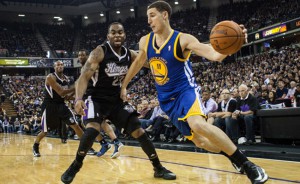Last night, the Boston Celtics upset the Indiana Pacers on a nice set that feigned an isolation for Paul Pierce and resulted in a wide open layup for Jeff Green The reaction to this play, exalted by some as the “best set of the year,” and referred to by bleacherreport.com, slamonline.com, and celticslife.com as “great,” displays the valuing of results over process that often infiltrates sports analysis. Had the Celtics run the exact same play and David West taken a better angle on Green’s cut towards the basket, he likely would have gotten around Pierce’s screen to cover Green and forced Kevin Garnett to enter the ball to Pierce for the Celtics secondary option, a wing isolation for Pierce. Though Pierce has good position, he likely would have struggled to score on Paul George. Had this happened, the Celtics set, hailed as the triumph of team play, would likely have been criticized as “hero ball.” The Celtic’s play was very well designed, as it gave them the Green cut, Pierce iso, and Garnett jumper as viable options, but may have been praised for the wrong reasons. I originally planned to look at this play, however Hoop Chalk beat me to it (http://hoopchalk.com/2013/03/06/celtics-use-the-elbows-to-take-out-pacers/), so instead I will break down Klay Thompson’s game winning three pointer against the Sacramento Kings, a broken play that fittingly ended a poorly executed game.
To begin the play, Jack sets a down screen for Steph Curry, freeing Curry to catch Thompson’s inbounds pass, while Jack clears baseline to the right corner and Thompson fills the left.
Though many teams wait until the final seconds to run a play, hoping to end the game with one shot. The Warriors initiate their play immediately, leaving themselves the opportunity for an offensive rebound and a second chance at a score. Bogut and Lee both move above the three-point line, preparing to set a drag-type screen to either free Curry for a jump shot or force a King’s big to switch onto him.
However, Andrew Bogut’s defender Jason Thompson, hedges the screen, stopping Curry and taking the Warriors out of their play. Typically, Patrick Patterson, David Lee’s defender, would have been the one hedging, as Lee set the first screen. Instead Thompson leaves Bogut, likely fearing that Patterson was not in position.
Toney Douglas, Curry’s original defender, clears Lee’s screen and, along with Jason Thompson, traps Curry. Thompson is expected to then recover to Bogut, but Bogut, recognizing that Thompson was overplaying Curry, had run away from the play into the paint. Because two defenders are guarding Curry, Patterson is forced to account for both Bogut and Lee, and sags off Lee. This leaves Lee open for Curry’s pass, however, because the original screening occurred so far from the basket, Jason Thompson is unable to immediately recover to Bogut, forcing Patterson to hesitate before stepping out on Lee.
To cover for Patterson’s hesitation, Klay Thompson’s defender, John Salmons, steps into the paint, denying Lee the driving lane, and giving Jarret Jack’s defender Tyreke Evans time to help on Andrew Bogut as Jason Thompson sprints to guard him. Seeing John Salmons pulled into the lane, Lee, an excellent passer, immediately hits Klay Thompson in the corner for an open three. Though they did not execute their initial option, the Warriors late game improvisation and Klay Thompsons shooting prowess allow the Warriors a little breathing room over the Rockets in the race for the 6th seed.







nice analysis ill check every day